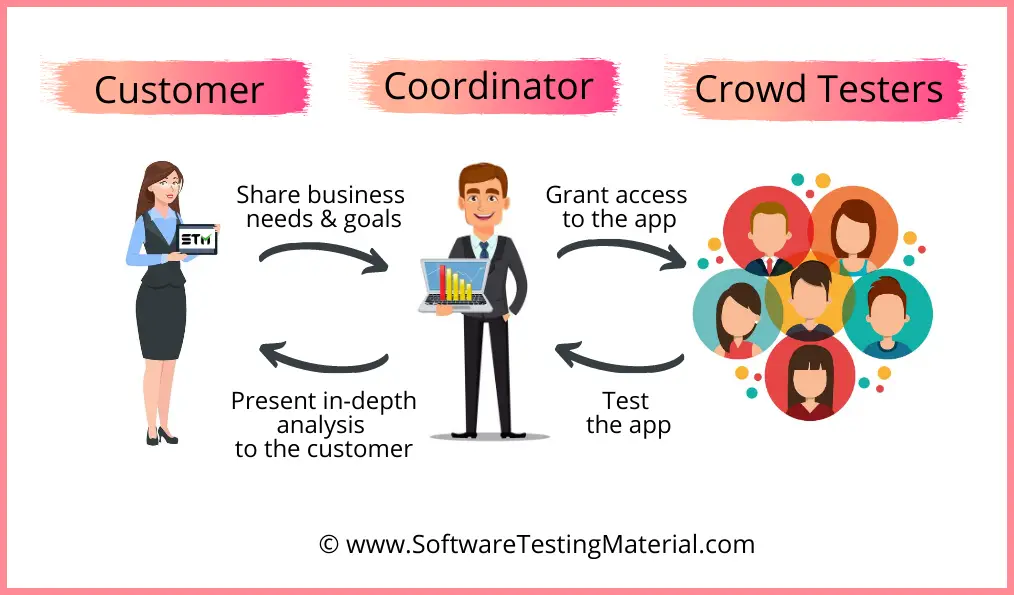Crowdsourced Testing Guide for Companies & Testers

Crowdsourced testing aka Crowd Testing and Global Testing is becoming a prominent trend in software testing which is different from traditional testing methods.
In this article, we will learn the following
What is Crowdsourced Testing?
It is carried out by a community of expert individual quality assurance testers (crowd testers) in different locations effectively and quickly.
Software such as websites, mobile apps, native desktop apps, etc., gets distributed to crowd testers through an online platform. Crowdtesters test the software using their experience on their computers or mobiles to identify defects.
It is reliable, cost-effective, and fast by diversifying the software into realistic platforms in different locations and to multiple individuals.
We know that the traditional way of software testing is conducted within the organization or through the outsourcing team.
Just like outsourcing of accounting, coding, web designing or web development, software QA and testing also can be outsourced. The crowdsourced testing is kind of outsourced testing but both have some differences. We can take the following scenario.
Assume there is a growing medical equipment company that launched its e-commerce website and mobile application and by this, they are expecting revenue through the selling of various medical and surgical equipment. This application and website will be used by the entire world and will be accessed on different operating systems and platforms, different browsers, and different mobile devices.
This company does not have an IT department inside, but somehow they managed Web development work within their premises. Now before Launch of the application to the Public, they need extensive testing. So to achieve a successful launch, Company can go for following options
1. Add an in-house testing team.
2. Outsource the testing work.
3. Go for Crowdsource testing.
Adding in-house testing team is not a good idea for them because they don’t see huge work for software testing people in future, it adds a huge amount of cost to the company in Hiring good and skilled testing personals, setting up a testing environment to perform different OS testing, mobile testing, providing salary and maintaining the work for a long time. So getting an in-house testing team is not a good idea for any organization which is not in a software business.
Difference between Outsourced Testing vs Crowdsourced Testing
Now let’s see the differences between Outsourced testing and Crowdsourced testing.
| Outsource Testing | Crowdsourced testing |
|---|---|
| A dedicated team is present to handle your testing Needs we can say it’s a third party which is unknown to you, test your application or product with a fresh set of mind. | A completely unknown pool of testing resources test your application, you can judge the quality of your product on the basis of number of bugs reported. |
| Payment is done on the basis of hours spent in testing, this estimation is done prior to the testing cycle. As an example testing outsourcing costs around 20 to 40$ per hour. | Payment is done on the basis of bug reported, no of severe bugs and low priority bugs. For example severe bug cost is 15$ and low priority bug is 3$ whereas medium priority bugs are costing 5$. |
| Application data is kept confidential and this is one of the code of ethics of every testing provider company. | Since there are n number of testers working on your application and they are not legally bound with Crowd source provider company, they are not bound to keep application data confidential. There are chances of data leakage if crowd source testing is done and no assurance of data privacy. |
| Communication is quite easy, because there is one representative always present to handle to share testing status, quality of your product. | Communication is bit tricky, because you have to understand the product quality on the basis of bugs logged by testers, you have to understand the bug by talking to the tester individually. |
| Quality is not compromised, since the objective is to identify all the bugs, within time and within budget. Entire team works to achieve this milestone, They present potential and valid bugs and organization is confident enough to fix only those bugs and get assured about their product quality. | Since there is no team concept, here focus is more on Quantity rather than quality. There are chances that your application is tested by 1000 of testers of different experiences. They may log 5K bugs of different severity. So its organization’s responsibility to identify the real bugs and fix them. |
| Testing platform and environment is completely owned by outsourced company, they are well settled with all useful software, tools, management tools, OS and Devices. | Testing environment is totally dependent on individual tester, some testers are on testing on MAC machine or some are testing on Windows, some are testing on Android or some are testing on Apple. |
| Skilled testers are in the team, there are fixed no of testers in the team. Each tester is well skilled in a particular area like mobile testing, performance testing, automation testing, functional testing. | Huge no of testers, with different expertise and different years of experiences, so chances of quality bugs depends of expertise of testers. Which may be surprisingly good or bad too. |
| One team, one time zone, restricted deadline, and planned budget, in this way testing cycles are complete. | No team concept, Different time zones, no deadlines but bugs are reported very fast. |
| Bugs reported are generally predictive in nature because testers work within a scope of testing. They don’t touch few areas because it may not in their budget. | Here no limitations of testing scope, N no of testers, n no of directions of breaking the system, Due to this testing cycle goes through a real scenario, for example n number of users are accessing application they might get some security flaw in the application. |
| High paid in comparison to Crowd sourced testing but lesser than Inhouse Testing team. | Budget friendly, quick results some time real and unexpected issues are identified. |
Crowdsource testing approach
Crowdsource testing providers adopt different ways to provide testing services, given below
1. Self-service approach: Customer is a techy [well into IT], and can directly interact with testers and understand the issues and concerns.
2. Managed approach: Customer interacts with a dedicated resource to get high-level testing insights rather than directly interacting with testers.
3. API: Customer doesn’t directly interact with testers or not any resource, they requests tests to run via an API
4. Mixed: As per the need, it can be a combination of all the above 3 ways.
Phases of Crowdsourced Testing
Let us now look at the widely used Crowdsourced Testing process:

Initiation Phase
Customer posts the project in the crowd testing platform and defines business needs and goals which they want to achieve over a period of time.
Preparation Phase
Project coordinator designs test plan prepares test cases, recruits crowdsourced testers, define deliverables, and share the environment details and test cases with the customer.
Execution Phase
Crowd testers across the globe start executing the test cases across required devices and browsers. Test results and the bugs will be shared with the project coordinator.
Evaluation Phase
Coordinator reviews the defect posted and process tester’s compensation.
Completion Phase
Share the test results to the customer. Rate crowd testers and close the cloud test cycle.
Where Crowdsourced testing is beneficial
Exploratory Testing:
Usually, crowdsourced testers explore the application to ensure the app is working as expected. These testers use their experience to find real-world bugs.
Performance Testing:
When the company wants to understand how their application behaves when no of users increased on the application, how the system gets recovered when an application crashes, and validate other things like throughput, and data volume.
Localization testing:
Testers from different countries and locations always help to find the real kind of localization issues.
Compatibility Testing:
Browser specific or Device testing – Since there are ‘n’ no of tester involved, they help the company to test the application with ‘n’ no of browsers, devices, and operating systems which is not very feasible in the standard way of testing.
Connectivity Testing:
Real scenarios related to connectivity and network are identified when crowdsource testing is performed.
Usability testing:
When testing of user-friendliness – All testers are from different backgrounds, they have different angles of looking at their comfort zone with the application, and they log so many real and genuine User experience issues which are never possible in a standard way of testing.
Advantages of Crowdsourced testing
1. It’s easy to handover testing and quality work to a virtual team, which is available for 24×7 rather than making an in-house testing team and arranging resources for testing, it is considered to be a very fast, and very cost-effective way.
2. Crowdsource testing works on a pay per valid bugs, this way company pays only for valid bugs which are very pocket friendly.
3. All testers are working virtually, no interaction with the development team or any other tester, in this way he is only responsible for application understanding and making an unbiased approach for testing. He becomes keener to understand the functional logic of application under test.
4. Multi-lingual testing, Localization testing, accessibility testing all are added advantage of Crowdsourced testing, so many critical issues are identified which may not possible in regular testing.
5. User experience testing is the key which is very well tested in crowdsourced testing where real scenarios are tested in an honest way.
6. Testing of performance and security of the application in a real scenario is achieved without investing in a costly tool. Stress and Load testing also can good insights about application performance without paying extra to a third party.
Disadvantages of Crowd testing
1. Since there is no guarantee of data security, this is always risky to give your application to unknown people, there might be chances that some important data is utilized for other purposes, or application logic is disclosed to some other competitive organizations.
2. Some time communication is very difficult because every tester is working in a different time zone, there is no management involved, there is no rule of status reporting.
3. Every tester does not look for the quality of the bugs, they only want to increase the bug list, and to achieve this they log less severity or non-impact bug as well which unnecessary makes bug list very long, and very crowdy. Figuring out the valid bugs is a very difficult task for the company representatives.
4. No model is used in crowdsourced testing, no rules, no management. Just like the Agile and Waterfall model where the requirement is well written and clear to every team member, in the crowdsource testing model all success of the testing depends on the skills and experience of the tester.
How Can I Become A Crowd Tester?
Did You Know You Can Earn Money Testing Mobile & Web Apps?
Yes, you can become a freelance tester and earn money in your spare time.
It is one of the most overlooked opportunities by talented testers like you.
Register in any crowdsourced testing companies where there is an opportunity for crowd testers. After registration follow their guidelines like updating your profile (technical skills, devices list, billing details). After your application is accepted you will get notified whenever a new project is available.
How Much Can I Earn?
You are paid for the accepted bugs you find and report. Mostly they pay will be around $5 for a low severity bug and $50 for a critical bug. Sometimes it may vary.
Few companies pay you per bug basis, few pay you on an hourly basis and few offer you a free app in return for your valuable time to find bugs.
Skills required to be a Crowdsourced tester
1. Highly skilled: Testers should be highly-skilled, quick learners, good at analytical and logical reasoning. Because the success of the testing depends on the skill set of a tester. Since there is no management or reporting protocol tester has to be very smart enough to do exploratory testing and find out the critical and functional bugs to the client.
2. Knowledge about tools and technology: Testers should be well versed with the latest technology and tools so that they can quickly apply the knowledge in application testing rather than first exploring it and then start testing.
3. Good in Communication: Testers must be good in verbal and written communication, they must be very good at logging bugs into the tool, in a clear and step by step manner. He should be able to demonstrate the issue by screenshots, by perfect steps and video recordings.
4. Team player: However there is no concept of team in Crowdsourced testing, but still he should understand if some bug is logged by some other tester then he should not log the repetitive bugs to the tool.
5. Follow the code of ethics: There is no control over the integrity of individual tester, but tester should be honest for his work, he should be able to win client trust and confidence so that he gets more chances & more challenging tasks in the future.
Where Can I Find Paid App Testing Opportunities?
There are many site offer paid app testing opportunity. Below we list the most popular ones who give paid mobile app testing opportunities.
Crowd Testing Companies
We have published a detailed post on the best Crowdsourced Testing companies.
In general, crowdsourcing testing platforms have a portfolio to present about what they provide, how many clients are associated with them, what services they are offering, how much testers are connected with them, and Pricing details.
For a tester they have a separate mechanism for testing personal, the tester gets a separate dashboard where they can see on how many projects he is working on, he can log bugs for each application under test he is assigned for, he can keep eyes on his account balance.
Conclusion
As a conclusion, we can say that crowdsourced testing is very demanding and cost-effective as well as very fast as compared to the standard testing model, but building a crowd testing network is not an easy task, where tester skill set and communication key is the big role player.
Moreover, crowd testing is well suited for those companies whose requirement is to test application look and user-friendliness or usability, localization, plus they are only concerned about the real-world testing scenarios. It’s not suitable for any company which is dealing with confidential data or records, or on the unique concepts.
Crowdsourced testing is gaining popularity because it is cost-effective and very fast, but certainly, it can not replace the standard testing model.
Related posts:


